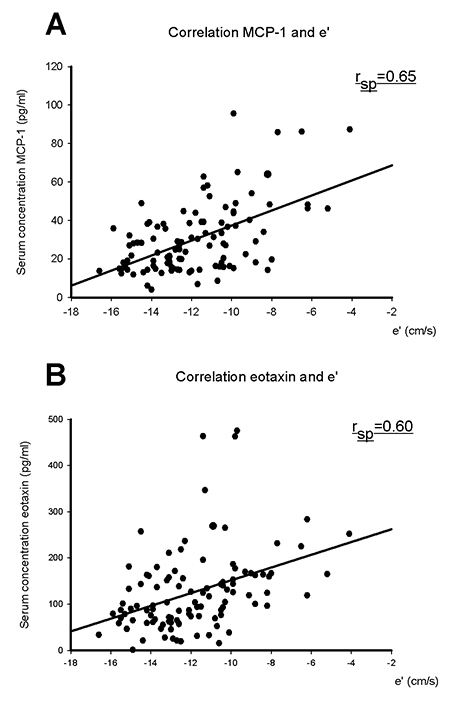Session Information
Session Type: Abstract Submissions (ACR)
Background/Purpose : Juvenile dermatomyositis (JDM) is a vasculopathic disease affecting not only skeletal muscle and skin, but other organs as well. Previously we have shown that JDM patients can have cardiac dysfunction (measured by E/e’). Considering the systemic nature of the disease, it is reasonable to believe that inflammation of the myocardium can occur, similar to what is seen in skeletal muscle. Increased abundance of pro-inflammatory cytokines has been shown in cardiac and rheumatic diseases. We examined associations between cytokine levels and cardiac parameters in patients with JDM and matched controls.
Methods: 54 JDM patients (estimated to represent the vast majority of known cases in Norway diagnosed from 1970-2006) were clinically examined, follow-up time median 16.8 years (range 2-38 years) after disease onset, and compared with 54 age- and sex-matched controls. Disease activity score (DAS) and myositis damage index (MDI) were assessed at follow-up by clinical examination and at 1 year post-diagnosis by chart review (DAS and MDI 1 year). Cytokines were analyzed by Luminex technology. Echocardiography with tissue Doppler was performed and analyzed blinded to patient information.
Results: Early diastolic tissue velocity (e’) that reflects diastolic cardiac function, was lower in JDM patients than in controls (11.2 vs.12.6 cm/s, p=0.004), suggesting diastolic dysfunction in JDM. E’ correlated with MDI 1 year, MDI at follow-up and DAS 1 year (rsp=0.46, rsp=0.59 and rsp=0.60, all p<0.001). Also, DAS 1 year predicted a low e' (diastolic dysfunction), at follow up after correcting for gender and age in a linear regression model (standardized β=0.38, p<0.001). In patients, the serum level of the two CC chemokines, monocyte chemoattractant protein-1 (MCP-1) and eotaxin, correlated with e’ (rsp=0.65 and rsp=0.59, both p<0.001) (Figure). For MCP-1, association with e' was also present after adjusting for disease duration and gender in a linear regression model (standardized β=0.36, p=0.001). No correlations were seen between the two CC chemokines and systolic parameters. MCP-1 and eotaxin also correlated with diastolic blood pressure (rsp=0.46 and rsp=0.50 both p<0.001). In controls, the CC chemokines did not correlate with any echocardiographic or clinical parameters.
Conclusion : Patients with JDM had subclinical diastolic dysfunction (measured by e’) compared to controls, and those with sustained early disease activity seemed to be at risk later in life to develop diastolic dysfunction. Considering the correlation with e’, MCP-1 and eotaxin might be involved in an inflammatory response in JDM, leading to myocardial fibrosis and subsequently diastolic dysfunction. The findings give new insight in the mechanism of myocardial affection and indicate that CC chemokines should be further studied to clarify a role as biomarkers or novel therapeutic targets in JDM.
Figure
Disclosure:
T. Schwartz,
None;
I. Sjaastad,
None;
B. Flatø,
None;
M. Vistnes,
None;
G. Christensen,
None;
H. Sanner,
None.
« Back to 2012 ACR/ARHP Annual Meeting
ACR Meeting Abstracts - https://acrabstracts.org/abstract/monocyte-chemoattractant-protein-1-and-eotaxin-are-associated-with-parameters-of-cardiac-dysfunction-in-juvenile-dermatomyositis/

